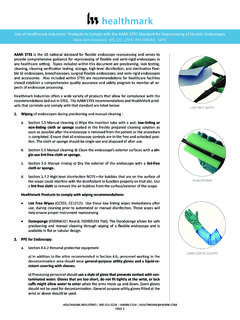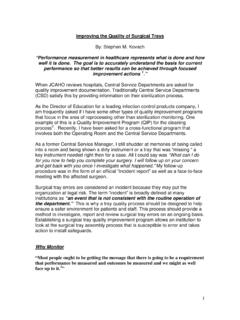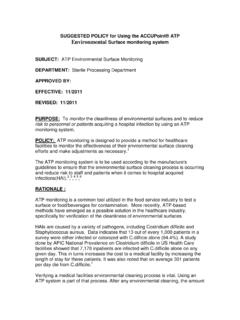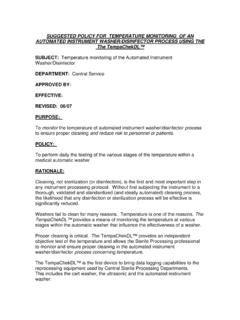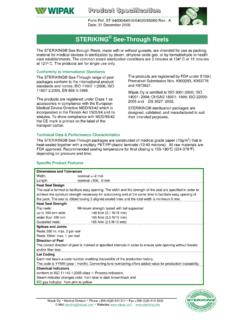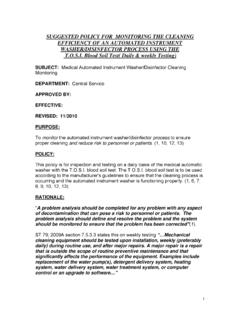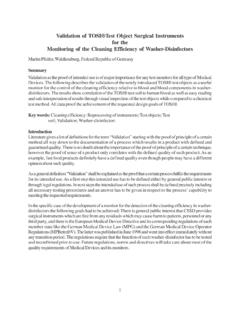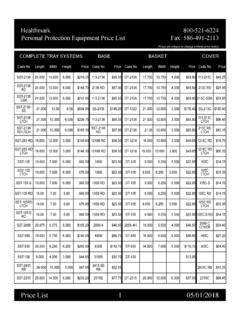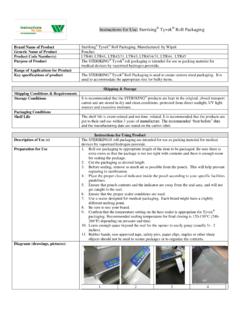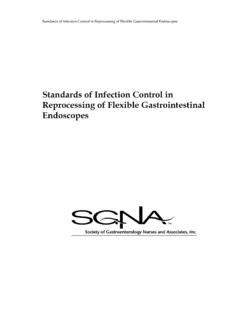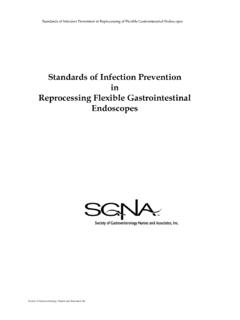Transcription of Support for Monitoring the Process of Cleaning Flexible …
1 Support for Monitoring the Cleaning Process for Flexible Endoscopes According to AAMI ST91, healthcare facilities should establish a comprehensive quality assurance and safety program to monitor all aspects of endoscope processing. This program should incorporate both visual inspections and testing of the equipment to identify conditions that may affect the Cleaning or disinfecting processes. Visual inspection alone may not be sufficient for assessing the efficacy of Cleaning processes. Therefore, the use of methods that are able to measure organic residues that are not readily detectable using visual inspection alone should be considered in facility Cleaning policy and procedures. The following statements from professional societies and governing bodies Support the use of a Cleaning verification Process for Flexible endoscopes: 1.
2 ANSI/AAMI ST91:2015, Flexible and semi-rigid endoscope processing in health care facilities . Testing Cleaning efficacy: The facility's onsite quality assurance program should include ways to verify that the Cleaning equipment used for processing of medical devices is working. Testing the equipment upon installation, during routine use (daily) and on all cycles used, after repairs, and when changing to a new type of Cleaning solution allows the user to verify its continued Manufacturer's written IFU should be consulted for recommendations of types and frequency of Cleaning efficacy testing. The frequency of testing the efficacy of the manual Cleaning step should occur on a regular basis, weekly or preferably daily (Drosnock 2014, Alfa 2014). Rationale: Meticulous manual Cleaning is essential for the removal of organic contamination that can interfere with high-level disinfection.
3 The manual Cleaning step is prone to error and therefore should be monitored on a basis at least as frequently as is recommended for the Cleaning equipment (see ANSI/AAMI ST79). This testing should include at a minimum Monitoring of the suction/biopsy channel (ANSI/AAMI ST58). While currently there is no universal consensus of the value of performing testing on endoscopes that have been through a high-level disinfection Process , numerous studies have identified the nature of microbial contamination likely to be found in improperly reprocessed endoscopes and have demonstrated the value of surveillance testing . AERs are designed to provide flow of solutions to internal channels. quality testing devices are available for many of the AERs to ensure that the solutions are flowing. To help ensure function of this equipment, testing should be performed at least weekly, after major repairs, or whenever there is a concern about equipment function.
4 Version 3/24/16. 2. AORN GUIDELINE FOR PROCESSING Flexible ENDOSCOPES 2016: a. Manual Cleaning of Flexible endoscopes should be verified using Cleaning verification tests when new endoscopes are purchased and at established intervals (eg, after each use, daily). i. Cleaning verification tests are used to verify the ability of the Cleaning Process to remove, or reduce to an acceptable level, the organic soil and microbial contamination that occurs during use of a reusable device. Cleaning verification tests include chemical reagent tests for detecting clinically relevant soils (eg, protein, carbohydrate) and ATP. Periodic verification of Cleaning effectiveness may help reduce errors in manual Cleaning and improve effectiveness ii. Auditing the manual Cleaning of Flexible endoscopes provides an objective method for verifying cleanliness and helps ensure that insufficiently cleaned Flexible endoscopes are recleaned before HLD or sterilization.
5 Iii. A multidisciplinary team that includes infection preventionists, endoscopists, endoscopy processing personnel, and other involved individuals should establish the type of Cleaning verification test to be performed. iv. There are a number of tests that can be used to assess Cleaning efficacy. Chemical tests involve the use of a reagent and observing for a color change that indicates the presence of organic markers such as protein or blood. In a dual phase (ie, simulated-use, inuse) study to validate the use of an audit tool composed of reagent test strips in 43 endoscopy clinics across Canada, Alfa et al collected samples from 30 patient-used endoscopes (ie, 10 colonoscopes, 10 duodenoscopes, 10 gastroscopes) and tested them for residual protein, carbohydrate, and hemoglobin using the audit tool test strips.
6 The test strips had three reagent pads designed to rapidly detect organic residualsof protein, carbohydrate, and hemoglobin after manual Cleaning . The researchers confirmed that the audit tool flagged endoscopes with residual protein, hemoglobin, or carbohydrate. v. There are quantitative tests that can be used for Cleaning verification testing of other residual soils, including: protein, carbohydrate, hemoglobin, vi. The multidisciplinary team should evaluate the need to implement protocols for Cleaning verification testing of Flexible duodenoscopes with elevator channels. b. Records related to Flexible endoscope processing should include the date and time, identity of the endoscope and endoscope accessories, method and verification of Cleaning and results of Cleaning verification testing.
7 Version 3/24/16. 3. SGNA Standard of Infection Prevention in the Gastroenterology Setting: a. The use of Cleaning monitors for automated washers may help to ensure adequate functioning (Alfa, 2013). b. Visibly clean is a method routinely used to assess the adequacy of manual Cleaning (Alfa et al., 2012; Rutala et al., 2008). This may involve the use of a magnifying glass to inspect for gross soil. Visual inspection is insufficient to determine Cleaning adequacy in narrow and internal channels of a scope and cannot detect microorganisms or bioburden (Alfa, 2014). Rapid Cleaning monitors are available. These monitors can provide documentation on Cleaning efficacy but do not reflect microbial activity. Real-time testing of endoscope lumens/elevator channel should be done immediately after manual Cleaning so that any improperly cleaned devices are re-cleaned prior to HLD.
8 Facilities should consider the use of monitors to verify ongoing Cleaning adequacy (Alfa, 2013). c. Once there is confirmation that an endoscope has been properly reprocessed, it is suggested that a system exist for identifying scopes that are clean and ready to use (Rutala & Weber, 2004; CDC, 2015). 4. SGNA Standards of Infection Prevention in Reprocessing Flexible Gastrointestinal Endoscopes: a. Note: It is impossible to visualize internal channels. Literature suggests that, to confirm the adequacy of manual Cleaning , a rapid Cleaning monitor (or rapid audit tool) for residual organic soil can be used prior to high-level disinfection (Visrodia et al., 2014). If the tool results are positive, this allows for the re- Cleaning of the endoscope prior to disinfection. The frequency of the testing should be determined by the individual institutions (Alfa et al.)
9 , 2013, 2014; AAMI, 2015; ASGE, 2014). 5. ANSI/AAMI ST79 and quality Monitoring : Some types of mechanical Cleaning equipment are designed to clean and/or disinfect specific kinds of medical devices, such as endoscopes Mechanical Cleaning equipment should be tested upon installation, weekly (preferably daily) during routine use, and after major repairs ( ) . Section and ANNEX D states Health care personnel may perform verification tests as part of the overall quality assurance program. This verification may include the use of test devices that monitor the functionality of the Cleaning equipment in Cleaning surfaces and that ensure adequate fluid flow in equipment that has adaptors for lumened devices . Current data (Alfa, et al., 2002) indicate that for Flexible endoscopes that have been cleaned after use on patients, the average levels of soil markers are as follows: protein, < g/cm2; carbohydrate, < g/cm2; hemoglobin, < g/cm2; sodium ion, < 1 mole/cm2; and endotoxin, < EU/cm2 in the biopsy/suction channel.
10 (Section - Markers) . Version 3/24/16. Regarding verification of the Cleaning Process : processing personnel are increasingly aware of the need to control and standardize the steps taken to ensure the sterility of devices for patient use. Because disinfection and sterilization cannot be assured unless the Cleaning Process is successful, professionals in the field ought to seek out whatever means are available and practical to verify this function. A quality system would call for Monitoring and documenting decontamination processing parameters, whether the Process is accomplished by hand or mechanically . (Section ). Furthermore, visual inspection is not possible for the inner components of medical devices that have lumens or that are of nonsealed tubular construction ( , Flexible endoscope channels, laparoscopic accessory devices, biopsy forceps).
